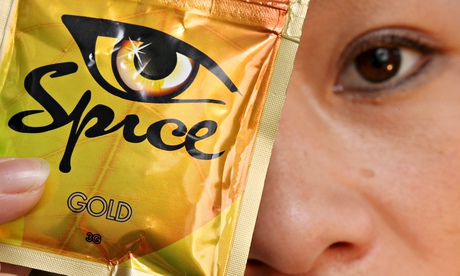
Valentina sifts a flaky mixture from a purple sachet into the end of a small pipe, holds a lighter to it, and inhales. Her voice becomes tense and high-pitched for a moment, then she relaxes. A faint, almost Christmassy odour of lightly stewed fruits wafts through the room.
This is a hit of spice, the collective name given to various synthetic smoking mixtures making headlines in Russia. On the market for five years, spice has the potential to be deadly.
According to Russian authorities, in recent weeks the spice epidemic has taken 25 lives and led to 700 people seeking medical attention. Hardly a day goes by without a fresh horror story of adolescents dying from the drug. Earlier this month a refugee from Luhansk in east Ukraine died after smoking with her friends in a town in southern Russia. Four others were taken to hospital.
Valentina has smoked for nearly two years. Now in her mid-30s, she was a heroin addict for a year after leaving university, but kicked the habit and was clean for more than a decade. She and her husband would occasionally smoke marijuana, and one day two years ago a friend brought a packet of spice over to their house and suggested they try it.
“We thought it was just like hash – not that addictive,” she recalls. She was wrong. Now, she and her husband buy their supply from a dealer each morning after dropping their children at school.
Much of the product is believed to be imported from China, though many say that labs in Russia are also churning out the mixtures. Along with older users such as Valentina, thousands of teenage Russians are using the substance.
Yevgeny Roizman, an anti-drug campaigner known for his rehabilitation centres for heroin addicts, warned this year of the consequences of the spice epidemic. “These drugs, unlike heroin, are much more widely used, they can be distributed more quickly and easily, they are harder to detect, and kids are starting to use them much younger,” he said. “The consequences are quick addiction, fast-paced decline, and as far as I can see, irreversible consequences which cannot be cured. Heroin in Russia is yesterday’s problem.”
Spice is a cannabis substitute made from various herbs with the addition of lab-synthesised chemicals. Authorities say the problem is that each time a smoking mixture is analysed and banned by authorities, the formula is altered and the newly legal mix can be sold again. Parliament is considering passing a bill to ban all synthetic smoking mixtures.
“The current system of fighting spice simply doesn’t work,” said Sultan Khamzayev, a member of Russia’s public chamber and an anti-drug campaigner, in a recent interview with a Russian website. “Chemists need just three hours to change the formula, but all the necessary bureaucratic work to identify and then ban a particular drug takes five months. That means for the whole period, people can simply sell any old poison.”
An MP from the far-right Liberal Democratic party, Roman Khudyakov, wrote recently that the death penalty should be introduced for spice dealers. “In a way, spice is much more dangerous than heroin,” says Valentina. “Most people have a hang-up about injecting, whereas spice you just smoke it in a pipe. By the time you realise how serious it is, it’s too late.”
The formula of the drug varies from batch to batch, and the way different versions interact with different people is always slightly different, but the main bonus for users is that any kind of fear and inhibition disappears. But withdrawal kicks in within a couple of hours and is often punishing.
“You lose all your coordination,” says one Muscovite spice addict. “You can’t think properly, and you can’t walk. It’s like being catastrophically drunk, but there is also a panic and terror. You begin to sweat, have crashing palpitations and feel sick. Often, you’ll simply begin projectile vomiting, with no warning. If I stop smoking now, within two hours I will be vomiting. It’s no better than heroin withdrawal, perhaps it’s even worse.”
Most dangerous is the withdrawal period for early-stage addicts, when the physical symptoms are mild but intense depression sets in. Valentina remembers days of total panic, and not realising until later that she was experiencing withdrawal symptoms.
“One day I stood up and I understood with absolute clarity that the only way for me to escape from the awful life I was in was to murder both of my children, and then kill myself,” she says. “I was crystal clear that this was the only course of action open to me. Luckily, my husband stopped me, and calmed me down. But what about people who don’t have that support?”
A typical week sees several news stories in Russian local press detailing horrendous deaths and suicides attributed to spice: children jumping from windows, heart attacks, even self-immolation. Valentina is convinced that the deaths that are reported are just the tip of the iceberg. Spice does not show up on ordinary toxicology tests and she thinks it could be a hidden trigger in violent crimes where there are no signs of mental illness or other drug use.
Spice is just the latest horror drug to hit Russia. Several years ago krokodil, a synthetic heroin substitute made from boiling codeine tablets with other ingredients, became popular. Devastatingly addictive, the drug would literally rot the flesh of users, leading to appalling wounds and a quick death. When the sale of codeine was banned two years ago, spice began to pick up in popularity.
“They ban one nightmare drug and another one pops up,” says Anya Sarang, a Russian activist who works on rights for drugs users. “It’s a natural consequence of the firefighting approach we have to drug use. Of course we need to ban spice, but if marijuana was legal, nobody would turn to these awful spice mixes to smoke. But of course, that’s a fairly unrealistic policy in the Russian climate.”
